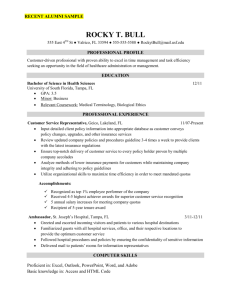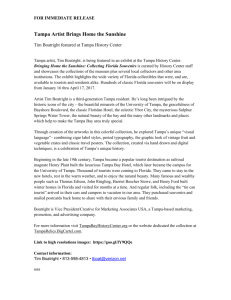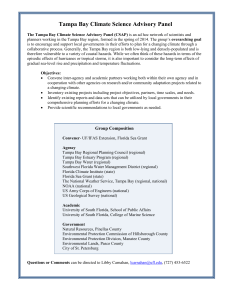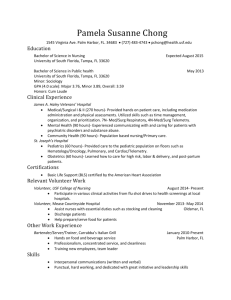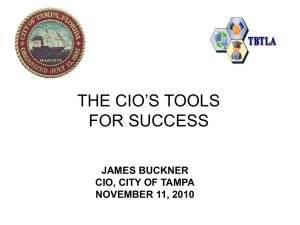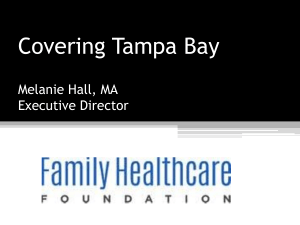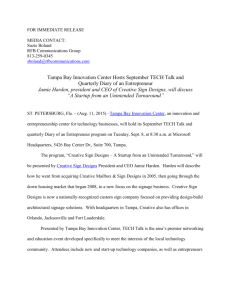West Tampa Economic and Community Development Plan
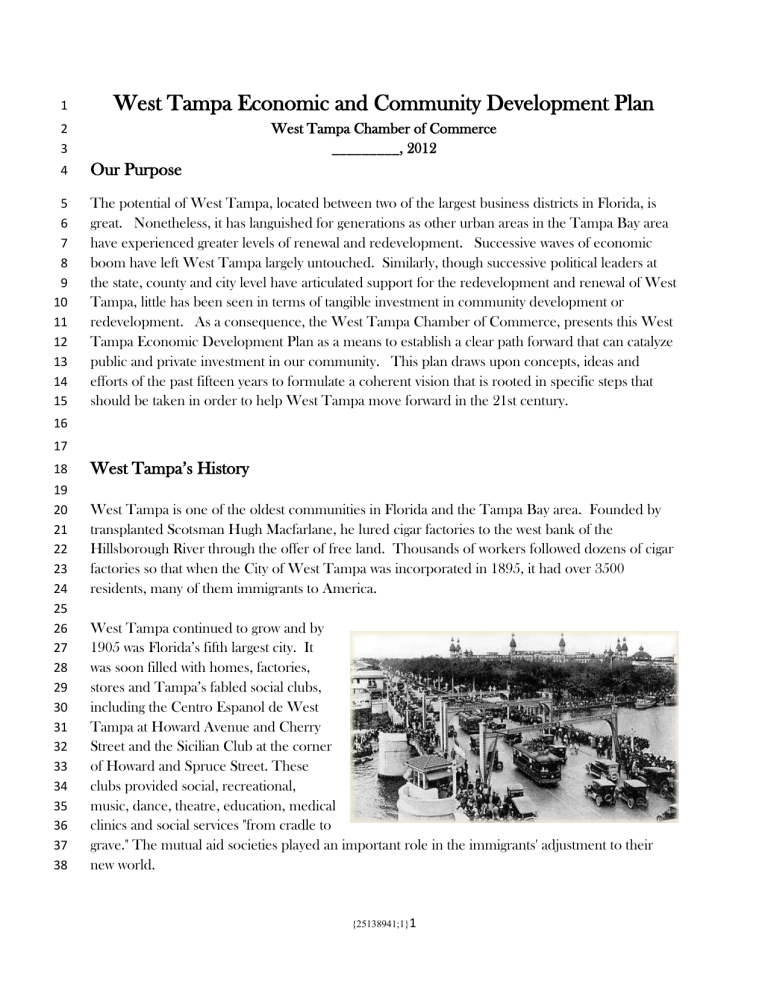
17
18
25
26
27
28
29
30
31
32
19
20
21
22
23
24
33
34
35
36
37
38
10
11
12
7
8
5
6
9
13
14
15
16
1
2
3
4
West Tampa Economic and Community Development Plan
West Tampa Chamber of Commerce
_________, 2012
Our Purpose
The potential of West Tampa, located between two of the largest business districts in Florida, is great. Nonetheless, it has languished for generations as other urban areas in the Tampa Bay area have experienced greater levels of renewal and redevelopment. Successive waves of economic boom have left West Tampa largely untouched. Similarly, though successive political leaders at the state, county and city level have articulated support for the redevelopment and renewal of West
Tampa, little has been seen in terms of tangible investment in community development or redevelopment. As a consequence, the West Tampa Chamber of Commerce, presents this West
Tampa Economic Development Plan as a means to establish a clear path forward that can catalyze public and private investment in our community. This plan draws upon concepts, ideas and efforts of the past fifteen years to formulate a coherent vision that is rooted in specific steps that should be taken in order to help West Tampa move forward in the 21st century.
West Tampa’s History
West Tampa is one of the oldest communities in Florida and the Tampa Bay area. Founded by transplanted Scotsman Hugh Macfarlane, he lured cigar factories to the west bank of the
Hillsborough River through the offer of free land. Thousands of workers followed dozens of cigar factories so that when the City of West Tampa was incorporated in 1895, it had over 3500 residents, many of them immigrants to America.
West Tampa continued to grow and by
1905 was Florida’s fifth largest city. It was soon filled with homes, factories, stores and Tampa’s fabled social clubs, including the Centro Espanol de West
Tampa at Howard Avenue and Cherry
Street and the Sicilian Club at the corner of Howard and Spruce Street. These clubs provided social, recreational, music, dance, theatre, education, medical clinics and social services "from cradle to grave." The mutual aid societies played an important role in the immigrants' adjustment to their new world.
{25138941;1}
1
11
12
13
14
15
8
9
6
7
10
16
17
18
19
20
3
4
5
1
2
21
Growth and prosperity continued for the next two decades but the winds of change blew strong in the 1920's. In 1925, exercising its new found political power that came with its own prosperity, the
City of Tampa annexed the City of West Tampa. Next came the Crash of October 1929 and the subsequent Great Depression that caused infinite hardships on Tampa's cigar workers. Major layoffs led to many departing for New York City or Havana.
WWII marked the end of the golden era of cigar manufacturing in Ybor and West Tampa.
Powerful societal, economic and geographic forces had profound impacts on West Tampa. For example, urban renewal destroyed an entire neighborhood known as Roberts City in the early 60s.
The state of Florida constructed I-275 through the heart of West Tampa and the lure of Tampa's expanding suburbs attracted many West Tampa residents. Consequently, West Tampa lost many important small businesses, further eroding the community's social fabric. Still, West Tampa was spared wholesale destruction of its housing stock as occurred in Ybor City, leaving a rich legacy of late 19th and early 20th century historic cigar worker homes at its core.
Today, West Tampa remains a neighborhood with a rich legacy of traditional and historic buildings and an urban pattern that creates a village within a city. Add to this its grid pattern, strategic location between the Central Business District and Westshore Business District, healthy inventory of traditional buildings, and a growing demand for urban living by people from all walks of like, and it is easy to see why West Tampa is poised for an urban renaissance.
22
{25138941;1}
2
1
Foundations for Community Development and Prosperity
2
3
12
13
14
15
16
17
7
8
9
10
11
4
5
6
18
34
35
36
37
24
25
26
27
28
29
19
20
21
22
23
30
31
32
33
Define and Brand West Tampa
1.
West Tampa’s Geography
We establish boundaries to define and describe places. Boundaries facilitate development of descriptive statistics while furnishing the foundation to communicate with the world where our homes or businesses are located. We define West Tampa as the geographic area bounded by Kennedy Blvd on the south, Dale
Mabry on the west, Hillsborough Avenue on the north and the Hillsborough River on the east. It is comprised of several distinct neighborhoods and has, as its center, the historic downtown and neighborhood of old West Tampa. Governmental, neighborhood and business associations may have different perspectives on these boundaries, but this is our sense of the economic and civic boundaries of
West Tampa.
Action item:
Official city recognition of boundaries by the City of Tampa and Hillsborough County.
2.
Adopt the West Tampa Logo
Visual images often carry with them powerful messages about place and its origins. Hence, establishing a mark for a place is a helpful starting point for establishing a brand. To this end, the West Tampa Chamber of Commerce undertook a process a to solicit community and membership input in 2005 and 2006 that led to consensus and adoption of a simple brand and logo for West Tampa that captures its traditions, its history and its desire to be a focal point for Tampa’s future economic and development progress.
Action item:
Recognition by the City of Tampa and Hillsborough County of the logo developed by the West
Tampa chamber of Commerce as the official logo of West Tampa.
{25138941;1}
3
32
33
34
35
36
37
38
23
24
25
26
27
28
29
30
31
1
17
18
19
20
10
11
12
13
14
15
16
5
6
7
8
9
2
3
4
21
22
3.
An Entry way and signage program for West Tampa
The recognition of “place” often revolves around physical attributes and demarcations. Identifying of a place is helped by designation of entry ways to it. To this end, the West Tampa Chamber of Commerce supports the development of an entry way and signage program utilizing the West Tampa logo. We also appreciate the limitations on public funds for capital and operating costs. Consequently, we recommend a program that would allow the development of standard entry way signage at key locations in either public or private rights of way that would also allow sponsorship opportunities for such signage.
Action item:
Adoption of a West Tampa Entry Way Public/Private Signage program
Adoption of standard entry way signage that include the West Tampa logo and which would include a "welcome" component as well as graphically consistent sponsorship recognition when appropriate.
Amendment of Tampa sign ordinance for private right of way signage or development of policies allowing private sponsorship of entry way signs in public right of way.
Application of West Tampa logo on appropriate public facilities, such as City of Tampa water tower.
4.
Create a Historic Landmark Illumination/Activation Program
Places also are defined by the notable buildings found in a specific area. The West Tampa National
Historic District is graced by some of Tampa’s and the Tampa Bay area’s most notable historically and architecturally significant structures, many of which are visible from I-275. These include buildings such as the Centro Espanol de West Tampa, Morgan Cigar Factory, Santaella Cigar Company and the Y. Pendas &
Alvarez Cigar Company, with its looming clock tower. A full listing and photos of these buildings can be found at http://www.cigarsoftampa.com/tpa-factoriesmap.html
. Accentuation of these buildings would help define the place of West Tampa as well as add definition to the City’s skyline.
Action Item:
Develop grant or property tax credit program for private property owners to pay for capital and operating costs to illuminate designated historic buildings and/or activate privately – owned community clock or bell towers.
5. Create Eating Guide to West Tampa
Places also are defined by culinary traditions and establishments. In this case, Columbus, Howard and
Armenia have one of the highest concentrations of independently owned and ethically diverse restaurants in the Tampa Bay area. Because West Tampa businesses and residents frequent these establishments, we
{25138941;1}
4
1
2
3
4
10
11
12
13
14
5
6
7
8
9
15 take them for granted. Yet, viewed from another perspective, these culinary treasures are unique and represent and untapped source of culinary adventure and experience that not only can help define West
Tampa but also provide a fresh and unique dimension to the Tampa experience.
Action Item:
Secure financial support from the City of Tampa and/or Tourist Development Council to develop and maintain an on-line and print eating guide to West Tampa featuring the numerous restaurants located in West Tampa.
{25138941;1}
5
1
2
3
Aggressively Pursue Economic Development Opportunities
1.
Redevelop the West Bank of the Hillsborough River
4
10
11
12
13
14
5
6
7
8
9
15
The single greatest economic opportunity for West
Tampa and the City of Tampa is the potential redevelopment of the west bank of the Hillsborough
River as a mixed-use, mixed-income waterfront community. The area bounded by the
Hillsborough River, Rome, I-275, and Columbus
Drive consists of over a hundred acres of developable land, yet it generated property tax income in 2012 of under $200,000 because most of this land is publicly owned.
18
26
27
28
29
30
31
19
20
21
22
23
24
25
32
33
34
35
Figure 1 Aerial view of West Bank with over one mile of riverfront with no general public use or access and no connection to historic neighborhood.
16
17
More troubling to the larger West Tampa community, the existing land uses cuts off the West Tampa from the river.
Adjacent neighborhood streets dead end into private apartment complexes, a city utility yard, county-owned offices and parking lots, and public school properties.
Rather than a riverfront park, the current waterfront uses along 5800 feet of riverfront include a private marina; privately used baseball fields; limited access school board owned athletic facilities including track, softball, baseball, and football fields; garden-style, rent-subsidized
Figure 2 Current West Bank Waterfront . apartments, and a number of private homes. Few of the existing land uses have densities or structures consistent with the style and economic values characteristic of urban waterfront land in other American cities. Finally, the long term presence of high concentrations of public and low income housing projects has contributed to the overall demise of housing and commercial properties in the adjacent West Tampa
National Historic District. At the same time, the current public housing complexes do not provide viable or satisfactory housing or community solutions to affordable rental housing for their residents.
36
{25138941;1}
6
1
2
3
4
5
6
7
8
9
10
Superior approaches for this area have been developed over the years. Over fifty years ago, a waterfront greenway was proposed for the West Bank by the Olmstead planning firm.
In 2000, the Florida 2012 Olympic committee proposed that the west bank be redeveloped as part of a proposed Olympic
Village, and a redevelopment plan was prepared to this end by Andres Duany, one of the leading proponents of and authorities on new urbanism in United States. This plan
27
28
29
30
31
32
33
34
35
36
37
38
21
22
23
24
25
26
12
13
14
15
16
17
18
19
20
Figure 3 West Bank Olympic Village Plan
11 included a strategy of relocating the existing public housing into more dispersed affordable housing in the urban core.
Subsequent thereto, a second redevelopment concept was pursued by the Civitas project. Though never pursued, the concept illustrated the potential options for creating a waterfront public realm and substantially increasing private investment in West
Tampa.
Figure 4 Civitas Riverfront Plan Post-Development
Finally, and more recently, the City of Tampa has been working with the Urban Land Institute to examine this area for potential redevelopment concepts and strategies. The initial recommendations of the diverse and experienced ULI panel studying this area called for its redevelopment in a manner that opens the riverfront to public enjoyment while providing greater economic development and housing opportunities for Tampa and the current residents of West Tampa.
Action Items:
Create an urban riverwalk along the west bank of the Hillsborough River from I-275 to
Columbus Drive.
Provide greater street and neighborhood connectivity to the Hillsborough River and West
Bank river walk.
Develop and implement a plan to relocate the existing public housing residents to new, dispersed public and affordable housing over a broader geographic area.
Redevelop the entire West Bank as a mixed-use, mixed income waterfront neighborhood.
Create a Community Redevelopment District bounded between Columbus Avenue,
Hillsborough River, I-275 and Habana Avenue to capture incremental tax revenues resulting from the redevelopment of this area.
{25138941;1}
7
22
23
24
25
26
18
19
20
21
27
1
2
13
14
15
16
8
9
10
11
12
3
4
5
6
7
17
2.
Redevelop the Historic West Tampa business district.
West Tampa has the only significant collection of historic commercial buildings and land use patterns in Tampa outside of Ybor City. Main Street, Howard, and Armenia Avenues still retain the vestiges of its glory days. Unlike Ybor City though, this historic district is surrounded by functioning residential neighborhoods, which also contain an abundance of historic residential structures. This is both a blessing and a disadvantage, the latter because it means that many historic commercial buildings cannot be economically activated because of a lack of parking, and the city’s regulatory environment makes it economically infeasible to develop parking in order to redevelop these properties. A similar issue beset
Ybor City, but while no resources have been invested in West Tampa to remedy the problem, its easterly cousin has seen close to one hundred million invested in parking and transit systems. Further, the Ybor
City area has been provided urban tools for its redevelopment, such as a Community Redevelopment
District to funnel incremental tax revenues into business district and community improvements. Finally, the
Tampa Housing Authority and City of Tampa placed a high priority on demolishing and redeveloping
Central Park Village, which had a significant blighting effect on surrounding neighborhoods. In contrast,
North Boulevard Homes remains and continues to thwart community investment and redevelopment.
Action Items:
Create an independent parking utility as recommended in the West Tampa Economic
Development Plan adopted by the City of Tampa and Hillsborough County Commission.
Utilize revenue from Community Development Block Grants and incremental tax funds from a CRA to provide funding to capitalize and operate such a parking utility.
Undertake a street beautification program on Howard, Armenia and Columbus using funds from the CRA or other sources.
Market and increase the capitalization of the existing low interest loan program for historic building rehabilitation within Old West Tampa.
{25138941;1}
8
1
2
13
14
15
16
8
9
10
11
12
3
4
5
6
7
17
18
19
20
21
22
23
24
25
32
33
34
35
36
26
27
28
29
30
31
37
38
39
40
3.
Catalyze New and Redeveloped Housing In West Tampa
West Tampa’s housing witnessed a downward spiral from the 1960’s until the late 1990’s. Many traditional homes in the historic district deteriorated, turned into havens of crime and source of blight, and were demolished. Most of the new housing developed during this time frame was city-financed, affordable housing. Much of this was concrete block housing that was uncharacteristic of the neighborhood and which subsequently has had a depressing effect on neighborhood characteristics and home values. West Tampa experienced its first resurgence of new housing between 2002 and 2007 when private builders such as
Castillo Homes and InTown Homes built market rate homes that were more characteristic of the neighborhood. However, the housing bust and large volumes of foreclosures caused housing values to dramatically decline, so that today the cost of land and construction exceeds the market value of the home.
This has halted any new construction. Further, many homeowners are significantly underwater, with the value of their home significantly less than their mortgage. The result has been homeowners walking away from their homes through foreclosure or bankruptcy. This reinforces the downward price trend and has result in an increase in rental properties. While local governments cannot stem the national housing tide, there are specific steps that can be undertaken to stimulate homeownership and catalyze new construction.
Action Items:
Establish a homeowner rehab and purchase program using section 203 FHA loans to facilitate acquisition of and rehabilitation of low cost rental homes for homeownership.
Provide down payment assistance to facilitate homeownership.
Eliminate or subsidize existing water and sewer capacity and connection fees for new construction as well as existing school construction impact fees until such time that market prices recover.
4. Redevelop Ft. Homer Hesterly Armory
The Ft. Homer Hestery Armory is one of the more unique economic, cultural, and historic asset in
West Tampa. The property itself is more than 10 acres, includes the historic national guard armory and is strategically located within a third mile of I-275 between Howard and Armenia. Several efforts have been undertaken by past city administrations to redevelop the property, which is currently owned by the Florida
National Guard but which reverts to the City of Tampa upon the Guard's relocation from the property.
The City of Tampa previously awarded development rights to a consortium led by the Coast Dental group to redevelop the site as a festive marketplace together with a hotel. Coast Dental also undertook significant property assemblage in the area, and had planned to relocate its corporate headquarters to the immediate area. The West Tampa Chamber of Commerce support this effort as representing a higher and better use of the property than competing proposals. Unfortunately, the effort failed due, at least in part, to the economic recession.
Subsequent thereto, the Jewish Community Center has entered into an agreement to explore the feasibility of redeveloping only the Armory Building as a cultural and recreation facility. This effort is presently underway. This may represent the most likely and financially feasible option for the redevelopment of the Armory building, but it faces strong competition from existing for-profit ventures,
{25138941;1}
9
4
5
6
7
8
9
1
2
3 such as LA Fitness and Powerhouse as well as not-for-profit entities such as the YMCA and Harbor Island
Athletic Club.
Action Item:
Support the effort of the JCC to redevelopment the Armory as a cultural and recreational facility.
In the event that the JCC venture is not feasible, the City of Tampa and state of Florida should work to relocate the National Guard to a new facility and remarket the existing property as a urban mixed-use redevelopment project.
{25138941;1}
10
1
7
8
9
4
5
6
10
11
12
13
14
15
16
17
18
19
20
27
28
29
30
31
32
21
22
23
24
25
26
33
34
35
36
37
38
39
40
2
3
Implement Strong Transit Systems in West Tampa to Create New and Revitalized
Urban Neighborhood
West Tampa has the strategic advantage of being located directly between and close to two robust business districts that have an abundance of commercial, retail, cultural, sports, educational and governmental assets in downtown and Westshore. It also has a strong network of east-west arterials and collectors running between these destinations. This means that transit could potentially provide competitive travel times compared to auto travel between West Tampa origins and destinations in downtown or
Westshore. Further, assuming that some level of dedicated lanes could be provided to transit, transit could also be competitive to car travel between downtown and Westshore. West Tampa also has a population that is demographically disposed to favor the use of transit. Indeed, during the community outreach phase of the 2006 economic plan effort, better and effective transit was the top priority of West Tampa's residents and businesses.
Over the course of the past decade, a variety of transit plans have advanced which proposed enhanced bus service within the city and county as well as the development of a light rail system that would run from downtown to Westshore. Various alignments were contemplated for the latter, including some combination of Cass, Cypress, and Main Street or, alternatively, along or on the interior of I-275. These all floundered, with the result that West Tampa (and the rest of Tampa) continues to be poorly served by transit.
1. Create a Mid-Town Circulator
As an outgrowth of the 2006 Economic Development Plan, stakeholders in West Tampa formulated a transit circulator concept called the MidTown shuttle. The MidTown shuttle contemplated pairs of counter-current circulators that would travel between Tampa International Airport/Westshore and downtown Tampa destinations via Kennedy, Cypress, Spruce, and Columbus. This plan also proposed that these circulator pairs would be criss-crossed with a line running from HCC and St. Joseph Hospital via
MLK and along Howard/Armenia and connecting to Tampa General Hospital. The Midtown shuttle was proposed to have long operating hours, 15 minute headways on-peak and 30 minutes off-peak. Due to the counter-current and circular nature of this approach, this plan would provide fairly high quality internal circulation in both West Shore and downtown Tampa. Threshold-to-threshold transit travel times within this corridor as compared to car travel would generally be competitive. HART's initially estimated operating costs for this system to be approximately $6 million annually. It should be emphasized that a number of these proposed routes already have fixed bus route service, which can practically be built upon.
Conceptual plans were presented to the Tampa Downtown Partnership and the Westshore Alliance and were generally well received. However, city and county leaders discouraged pursuit of this option, in favor of a county-wide referendum.
Several funding scenarios were conceived including a combination of a special taxing district and a tax increment finance district (including the county and city), mobility fees, developer contributions, state and federal transit grants and some level of private sponsorship. Alternatively, this system could funded through an appropriately transit referendum. It was viewed, and should be viewed, as an urban amenity for those businesses and residents living within the corridor, much as community centers, golf courses and
{25138941;1}
11
8
9
10
11
12
13
5
6
7
1
2
3
4
14
15
16
17
18
33 swimming pools are viewed as suburban amenities for master plan communities. The difference here is that the MidTown shuttle would provide residents and businesses within the service area with an opportunity to avoid the cost of owning and/or operating an automobile if they lived and worked within the
MidTown district. To this end, a special taxing district appeared to be a desirable potential initial funding option that could be implemented by the City of Tampa without any new legislation, with the residents and businesses within the Midtown area getting to use the service potentially for "free," because they otherwise would be supporting it through the taxing district. Properly framed and supported by appropriate land use and development regulations, this level of competitive transit service could accelerate property value appreciation and ultimately high quality, transit-oriented redevelopment and workforce housing that would be proximate to the Westshore and Downtown business districts. If combined with a transit tax increment finance district, the special taxing district could be reduced or phased out as the increment accrued revenues. This two-step approach may be particularly practical given the current state of property tax assessments.
Action Items:
Re-introduce and promote re-consideration and adoption of MidTown shuttle operating and develop alternative finance plans.
Promote establishment of Transit-oriented design land uses and land development regulations in connection with any implementation of MidTown plan.
29
30
31
32
26
27
28
19
20
21
22
23
24
25
2.
{25138941;1}
12
19
20
21
22
13
14
15
16
17
18
10
11
12
7
8
9
1
2
3
4
5
6
23
24
25
31
32
33
34
35
36
26
27
28
29
30
37
38
39
2. Create A Downtown-West Tampa-Westshore/TIA BRT route.
Establishment of high speed, high frequency bus rapid transit corridors connecting downtown
Tampa and surrounding areas to Westshore and Tampa International Airport has the potential for creating significant synergies by linking together a host of assets. The power and utility of such an option would be dramatically enhanced if it was supported and developed in connection with the MidTown shuttle system.
A strong candidate corridors exist and could be developed for relatively low capital costs.
The fastest and lowest cost candidate appears to be utilization of the median of a redeveloped I-275 between North Boulevard and Trask Street. The ultimate configuration of this section of the interstate calls for three exterior local lanes, two interior express lanes, and a two lane-transit envelop at the center.
Reconstruction of the outer lanes within this corridor is now underway. It appears that the remnants of the existing interstate lanes, at the conclusion of the current construction phase, may be able to be effectively reconfigured to provide a seamless express bus service opportunity in one of the most heavily congested interstate segments in the Tampa interstate system. Ultimately, these center lanes would be used on a regional basis, with a regional technology, but this option might not be available for a generation. Until such time, such a BRT option could be a powerful transportation and economic development investment for Tampa. Further, West Tampa would benefit from having an express bus stop on this BRT configuration within the media of I-275 at Howard and Armenia. Such a stop provide an opportunity for the economic activation and redevelopment of the center of historic downtown West Tampa.
Action Item:
TBART, the Tampa Aviation Authority, HART, FDOT, MPO and City of Tampa should proceed to develop options to implement a BRT connection between TIA and downtown
Tampa utilizing the median and transit ROW of a reconstructed I-275.
3. Identify and Incrementally Implement Light Rail Corridor between downtown Tampa and
Westshore/TIA.
Various planning efforts have evaluated different route options for a potential light rail connection between downtown Tampa and Tampa International Airport through West Tampa. The final environmental impact statement from the initial effort proposed a light rail line that generally followed an alignment running from Cass-North Bld-Main-Howard-Aremnia-Cypress-Trask-TIA. This alignment followed historic street car alignments and provided strong service to existing business and neighborhood districts, but was characterized by show travel times. More recently, an alternative analysis was performed by HART to identify alternative alignments. This study was never finalized, but it did arrive at two primary route options, the first of which was similar to the initial alignment, while the second alignment was either adjacent to or located in the median of I-275. These two alternative alignments reflect the tension between two important but competing priorities for fixed guideway transit, regional speed verses local access and associated redevelopment opportunities.
From West Tampa's perspective, both are important, but promoting localized transit oriented redevelopment in such a rich urban environment is the more value-laden option for both West Tampa and the taxpayers who would fund the service, as greater redevelopment and property appreciation would likely
{25138941;1}
13
5
6
7
8
1
2
3
4
9
10
11
12
13
14
15 occur around stations located within business districts and neighborhoods than adjacent to or in the media of the interstate. Accordingly, we believe that the I-275 corridor should be reserved for regional options such as BRT or a commuter style operation while any investment in light rail should be focused on more local service with frequent stops.
Finally, there is sentiment in some quarters that government must wait the approval of multi-billion dollar local transit initiatives with corresponding significant commitments of state and federal capital dollars. We believe a more incremental approach is both appropriate and feasible.
Action Items;
Identify the best light rail corridor between downtown Tampa and Tampa International Airport to accommodate neighborhood and business district service.
Develop phasing options for the corridor, starting with higher quality bus service, then Busrapid transit and finally, light rail transit. This assumes that the MidTown shuttle would utilize this corridor as a part of one of the operating circulator loops.
Adopt land use and development regulations to encourage and support transit oriented redevelopment in the designated corridor.
{25138941;1}
14
